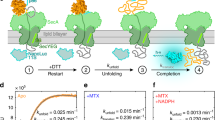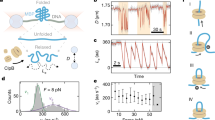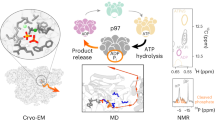Abstract
Molecular machines containing double or single AAA+ rings power energy-dependent protein degradation and other critical cellular processes, including disaggregation and remodeling of macromolecular complexes. How the mechanical activities of double-ring and single-ring AAA+ enzymes differ is unknown. Using single-molecule optical trapping, we determine how the double-ring ClpA enzyme from Escherichia coli, in complex with the ClpP peptidase, mechanically degrades proteins. We demonstrate that ClpA unfolds some protein substrates substantially faster than does the single-ring ClpX enzyme, which also degrades substrates in collaboration with ClpP. We find that ClpA is a slower polypeptide translocase and that it moves in physical steps that are smaller and more regular than steps taken by ClpX. These direct measurements of protein unfolding and translocation define the core mechanochemical behavior of a double-ring AAA+ machine and provide insight into the degradation of proteins that unfold via metastable intermediates.
This is a preview of subscription content, access via your institution
Access options
Subscribe to this journal
Receive 12 print issues and online access
$189.00 per year
only $15.75 per issue
Buy this article
- Purchase on Springer Link
- Instant access to full article PDF
Prices may be subject to local taxes which are calculated during checkout




Similar content being viewed by others
References
Neuwald, A.F., Aravind, L., Spouge, J.L. & Koonin, E.V. AAA+: A class of chaperone-like ATPases associated with assembly, operation, and disassembly of protein complexes. Genome Res. 9, 27–43 (1999).
Ogura, T. & Wilkinson, A.J. AAA+ superfamily ATPases: common structure–diverse function. Genes Cells 6, 575–597 (2001).
Sauer, R.T. & Baker, T.A. AAA+ proteases: ATP-fueled machines of protein destruction. Annu. Rev. Biochem. 80, 587–612 (2011).
Grimaud, R., Kessel, M., Beuron, F., Steven, A.C. & Maurizi, M.R. Enzymatic and structural similarities between the Escherichia coli ATP-dependent proteases, ClpXP and ClpAP. J. Biol. Chem. 273, 12476–12481 (1998).
Guo, F., Maurizi, M.R., Esser, L. & Xia, D. Crystal structure of ClpA, an Hsp100 chaperone and regulator of ClpAP protease. J. Biol. Chem. 277, 46743–46752 (2002).
Wang, F. et al. Structure and mechanism of the hexameric MecA–ClpC molecular machine. Nature 471, 331–335 (2011).
Liu, J. et al. Structural dynamics of the MecA-ClpC complex: a type II AAA+ protein unfolding machine. J. Biol. Chem. 288, 17597–17608 (2013).
Doyle, S.M. & Wickner, S. Hsp104 and ClpB: protein disaggregating machines. Trends Biochem. Sci. 34, 40–48 (2009).
Roll-Mecak, A. & McNally, F.J. Microtubule-severing enzymes. Curr. Opin. Cell Biol. 22, 96–103 (2010).
Wolf, D.H. & Stolz, A. The Cdc48 machine in endoplasmic reticulum associated protein degradation. Biochim. Biophys. Acta 1823, 117–124 (2012).
Zhao, C., Smith, E.C. & Whiteheart, S.W. Requirements for the catalytic cycle of the N-ethylmaleimide-sensitive factor (NSF). Biochim. Biophys. Acta 1823, 159–171 (2012).
Katayama, Y. et al. The two-component, ATP-dependent Clp protease of Escherichia coli: purification, cloning, and mutational analysis of the ATP-binding component. J. Biol. Chem. 263, 15226–15236 (1988).
Kress, W., Mutschler, H. & Weber-Ban, E.U. Both ATPase domains of ClpA are critical for processing of stable protein structures. J. Biol. Chem. 284, 31441–31452 (2009).
Aubin-Tam, M.E., Olivares, A.O., Sauer, R.T., Baker, T.A. & Lang, M.J. Single-molecule protein unfolding and translocation by an ATP-fueled proteolytic machine. Cell 145, 257–267 (2011).
Maillard, R.A. et al. ClpX(P) generates mechanical force to unfold and translocate its protein substrates. Cell 145, 459–469 (2011).
Sen, M. et al. The ClpXP protease unfolds substrates using a constant rate of pulling but different gears. Cell 155, 636–646 (2013).
Cordova, J.C. et al. Stochastic but highly coordinated protein unfolding and translocation by the ClpXP proteolytic machine. Cell 158, 647–658 (2014).
Carrion-Vazquez, M. et al. Mechanical and chemical unfolding of a single protein: a comparison. Proc. Natl. Acad. Sci. USA 96, 3694–3699 (1999).
Kenniston, J.A., Baker, T.A., Fernandez, J.M. & Sauer, R.T. Linkage between ATP consumption and mechanical unfolding during the protein processing reactions of an AAA+ degradation machine. Cell 114, 511–520 (2003).
Martin, A., Baker, T.A. & Sauer, R.T. Protein unfolding by a AAA+ protease is dependent on ATP-hydrolysis rates and substrate energy landscapes. Nat. Struct. Mol. Biol. 15, 139–145 (2008).
Miller, J.M., Lin, J., Li, T. & Lucius, A.L. E. coli ClpA catalyzed polypeptide translocation is allosterically controlled by the protease ClpP. J. Mol. Biol. 425, 2795–2812 (2013).
Weber-Ban, E.U., Reid, B.G., Miranker, A.D. & Horwich, A.L. Global unfolding of a substrate protein by the Hsp100 chaperone ClpA. Nature 401, 90–93 (1999).
Glynn, S.E., Martin, A., Nager, A.R., Baker, T.A. & Sauer, R.T. Structures of asymmetric ClpX hexamers reveal nucleotide-dependent motions in a AAA+ protein-unfolding machine. Cell 139, 744–756 (2009).
Stinson, B.M. et al. Nucleotide binding and conformational switching in the hexameric ring of a AAA+ machine. Cell 153, 628–639 (2013).
Nager, A.R., Baker, T.A. & Sauer, R.T. Stepwise unfolding of a β-barrel protein by the AAA+ ClpXP protease. J. Mol. Biol. 413, 4–16 (2011).
Cranz-Mileva, S. et al. The flexible attachment of the N-domains to the ClpA ring body allows their use on demand. J. Mol. Biol. 378, 412–424 (2008).
Martin, A., Baker, T.A. & Sauer, R.T. Rebuilt AAA+ motors reveal operating principles for ATP-fuelled machines. Nature 437, 1115–1120 (2005).
Hinnerwisch, J., Fenton, W.A., Furtak, K.J., Farr, G.W. & Horwich, A.L. Loops in the central channel of ClpA chaperone mediate protein binding, unfolding, and translocation. Cell 121, 1029–1041 (2005).
Smith, D.M., Fraga, H., Reis, C., Kafri, G. & Goldberg, A.L. ATP binds to proteasomal ATPases in pairs with distinct functional effects, implying an ordered reaction cycle. Cell 144, 526–538 (2011).
Flynn, J.M. et al. Overlapping recognition determinants within the ssrA degradation tag allow modulation of proteolysis. Proc. Natl. Acad. Sci. USA 98, 10584–10589 (2001).
Dougan, D.A., Reid, B.G., Horwich, A.L. & Bukau, B. ClpS, a substrate modulator of the ClpAP machine. Mol. Cell 9, 673–683 (2002).
Farrell, C.M., Grossman, A.D. & Sauer, R.T. Cytoplasmic degradation of ssrA-tagged proteins. Mol. Microbiol. 57, 1750–1761 (2005).
Moore, S.D. & Sauer, R.T. The tmRNA system for translational surveillance and ribosome rescue. Annu. Rev. Biochem. 76, 101–124 (2007).
Koodathingal, P. et al. ATP-dependent proteases differ substantially in their ability to unfold globular proteins. J. Biol. Chem. 284, 18674–18684 (2009).
Gur, E., Vishkautzan, M. & Sauer, R.T. Protein unfolding and degradation by the AAA+ Lon protease. Protein Sci. 21, 268–278 (2012).
De La Cruz, E.M. & Ostap, E.M. Relating biochemistry and function in the myosin superfamily. Curr. Opin. Cell Biol. 16, 61–67 (2004).
Kerssemakers, J.W. et al. Assembly dynamics of microtubules at molecular resolution. Nature 442, 709–712 (2006).
Werbeck, N.D., Schlee, S. & Reinstein, J. Coupling and dynamics of subunits in the hexameric AAA+ chaperone ClpB. J. Mol. Biol. 378, 178–190 (2008).
Maglica, Z., Striebel, F. & Weber-Ban, E. An intrinsic degradation tag on the ClpA C-terminus regulates the balance of ClpAP complexes with different substrate specificity. J. Mol. Biol. 384, 503–511 (2008).
Gur, E. & Sauer, R.T. Recognition of misfolded proteins by Lon, a AAA+ protease. Genes Dev. 22, 2267–2277 (2008).
Bewley, M.C., Graziano, V., Griffin, K. & Flanagan, J.M. The asymmetry in the mature amino-terminus of ClpP facilitates a local symmetry match in ClpAP and ClpXP complexes. J. Struct. Biol. 153, 113–128 (2006).
Maurizi, M.R., Singh, S.K., Thompson, M.W., Kessel, M. & Ginsburg, A. Molecular properties of ClpAP protease of Escherichia coli: ATP-dependent association of ClpA and ClpP. Biochemistry 37, 7778–7786 (1998).
Aubin-Tam, M.E. et al. Adhesion through single peptide aptamers. J. Phys. Chem. A 115, 3657–3664 (2011).
Kim, Y.I., Burton, R.E., Burton, B.M., Sauer, R.T. & Baker, T.A. Dynamics of substrate denaturation and translocation by the ClpXP degradation machine. Mol. Cell 5, 639–648 (2000).
Acknowledgements
This work was supported by the Howard Hughes Medical Institute (HHMI) (T.A.B.) and US National Institutes of Health (grant AI-16892; R.T.S.). T.A.B. is supported as an employee of HHMI. We thank T. L. Sherpa for help, S. Calmat, A. Torres-Delgado and E. Vieux (Massachusetts Institute of Technology) for providing proteins and M. Aubin-Tam (Technische Universiteit Delft) and M. Lang (Vanderbilt University) for discussions and advice.
Author information
Authors and Affiliations
Contributions
A.O.O. performed and analyzed optical-trapping experiments, performed biochemical experiments and constructed and purified ClpA variants. A.R.N. constructed, purified and assembled the biotinylated, mixed-ring ClpP enzyme used for single-molecule studies. O.I. constructed and purified the multidomain titin-GFP substrate. All authors contributed to writing the manuscript.
Corresponding authors
Ethics declarations
Competing interests
The authors declare no competing financial interests.
Rights and permissions
About this article
Cite this article
Olivares, A., Nager, A., Iosefson, O. et al. Mechanochemical basis of protein degradation by a double-ring AAA+ machine. Nat Struct Mol Biol 21, 871–875 (2014). https://doi.org/10.1038/nsmb.2885
Received:
Accepted:
Published:
Issue Date:
DOI: https://doi.org/10.1038/nsmb.2885
This article is cited by
-
Processive extrusion of polypeptide loops by a Hsp100 disaggregase
Nature (2020)
-
The molecular principles governing the activity and functional diversity of AAA+ proteins
Nature Reviews Molecular Cell Biology (2020)
-
The SecA motor generates mechanical force during protein translocation
Nature Communications (2020)
-
Simultaneous sensing and imaging of individual biomolecular complexes enabled by modular DNA–protein coupling
Communications Chemistry (2020)
-
The peroxisomal AAA-ATPase Pex1/Pex6 unfolds substrates by processive threading
Nature Communications (2018)



